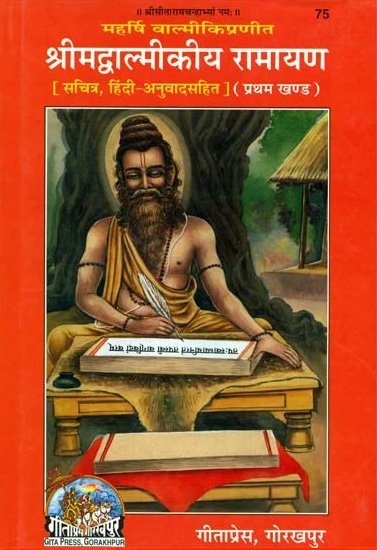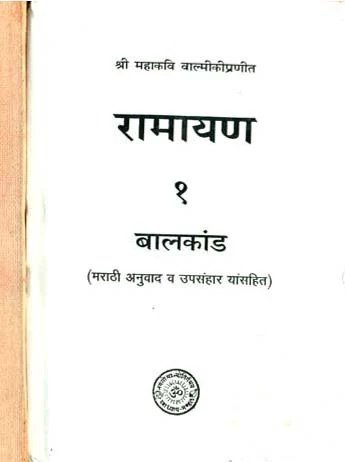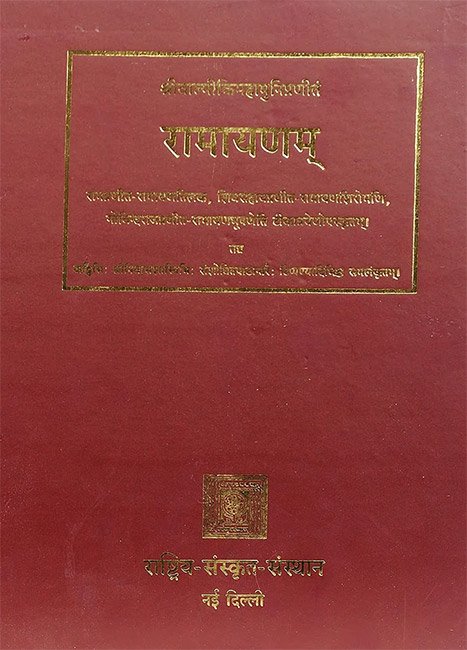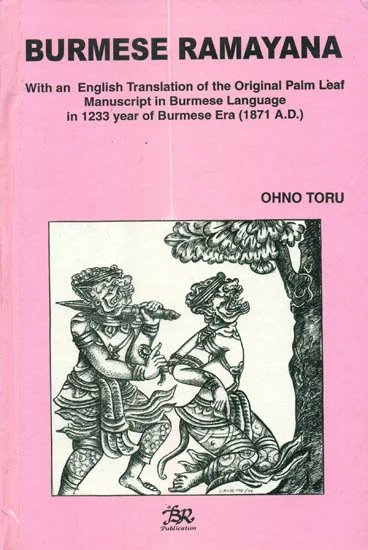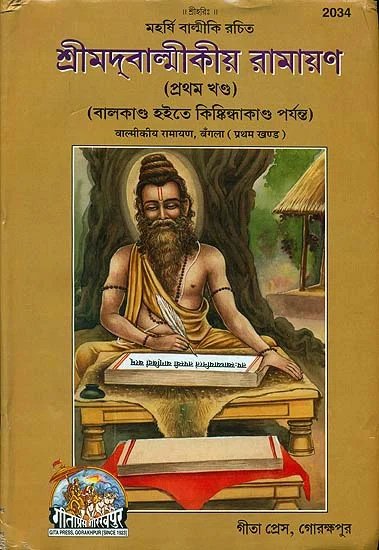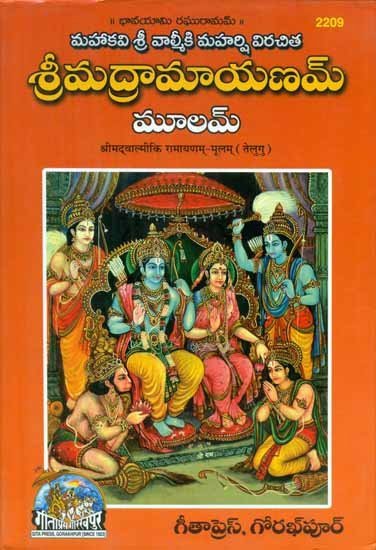Ramayana [sanskrit]
175,075 words | ISBN-10: 8129302500 | ISBN-13: 9788129302502
This Sanskrit edition of the Ramayana: An ancient epic revolving around the life and legends of Rama, Sita and Ravana. Original titles: Vālmīki Rāmāyaṇa (वाल्मीकि रामायण) or Vālmīkirāmāyaṇa (वाल्मीकिरामायण)
Verse 2.3
संतापस्य च ते स्थानं न हि पश्यामि राघव ।
प्रवृत्ताव् उपलब्धायां ज्ञाते च निलये रिपोः ॥ ३ ॥
saṃtāpasya ca te sthānaṃ na hi paśyāmi rāghava |
pravṛttāv upalabdhāyāṃ jñāte ca nilaye ripoḥ || 3 ||
The English translation of Ramayana Verse 2.3 is contained in the book Valmiki-Ramayana by Gita Press, Gorakhpur. This book is not available online so in order to read the full text and translation you should buy the book:
Buy now! English translation by Gita Press, Gorakhpur (2011)
Glossary of Sanskrit terms
Note: This extracts Sanskrit terms and links to English definitions from the glossary, based on an experimental segmentation of verse (2.3). Some terms could be superfluous while some might not be mentioned. Click on the word to show English definitions.
Santapa, Tad, Yushmad, Sthana, Pashya, Amin, Raghava, Upalabdha, Jnata, Jnati, Nilaya, Rip, Ripu,
Analysis of Sanskrit grammar
Note: this is an experimental feature and only shows the first possible analysis of the Sanskrit text (Ramayana Verse 2.3). If the system was successful in segmenting the sentence, you will see of which words it is made up of, generally consisting of Nouns, Pronouns, Verbs, Participles and Indeclinables. Click on the link to show all possible derivations of the word.
- Line 1: “saṃtāpasya ca te sthānaṃ na hi paśyāmi rāghava ”
- santāpasya -
-
santāpa (noun, masculine)[genitive single]santāpa (noun, neuter)[genitive single]
- ca -
-
ca (indeclinable conjunction)[indeclinable conjunction]ca (noun, masculine)[compound], [vocative single]ca (noun, neuter)[compound], [vocative single]
- te -
-
ta (noun, masculine)[locative single]ta (noun, neuter)[nominative dual], [vocative dual], [accusative dual], [locative single]tā (noun, feminine)[nominative dual], [vocative single], [vocative dual], [accusative dual]tad (noun, neuter)[nominative dual], [accusative dual]sa (noun, masculine)[nominative plural]sā (noun, feminine)[nominative dual], [accusative dual]yuṣmad (pronoun, none)[dative single], [genitive single]
- sthānam -
-
sthāna (noun, neuter)[adverb], [nominative single], [accusative single]
- na -
-
na (indeclinable particle)[indeclinable particle]na (noun, masculine)[compound], [vocative single]na (noun, neuter)[compound], [vocative single]
- hi -
-
hi (indeclinable particle)[indeclinable particle]
- paśyā -
-
paśya (noun, masculine)[compound], [vocative single]paśya (noun, neuter)[compound], [vocative single]paśyā (noun, feminine)[nominative single]√paś -> paśya (participle, masculine)[vocative single from √paś class 10 verb]√paś -> paśya (participle, neuter)[vocative single from √paś class 10 verb]√paś -> paśyā (participle, feminine)[nominative single from √paś class 10 verb]
- ami -
-
amin (noun, masculine)[compound], [adverb]amin (noun, neuter)[compound], [adverb], [nominative single], [vocative single], [accusative single]
- rāghava -
-
rāghava (noun, masculine)[compound], [vocative single]
- Line 2: “pravṛttāv upalabdhāyāṃ jñāte ca nilaye ripoḥ ”
- Cannot analyse pravṛttāv*up
- upalabdhāyām -
-
upalabdhā (noun, feminine)[locative single]
- jñāte -
-
jñāta (noun, masculine)[locative single]jñāta (noun, neuter)[nominative dual], [vocative dual], [accusative dual], [locative single]jñātā (noun, feminine)[nominative dual], [vocative single], [vocative dual], [accusative dual]jñāti (noun, masculine)[vocative single]√jñā -> jñāta (participle, masculine)[locative single from √jñā class 3 verb], [locative single from √jñā class 9 verb]√jñā -> jñāta (participle, neuter)[nominative dual from √jñā class 3 verb], [vocative dual from √jñā class 3 verb], [accusative dual from √jñā class 3 verb], [locative single from √jñā class 3 verb], [nominative dual from √jñā class 9 verb], [vocative dual from √jñā class 9 verb], [accusative dual from √jñā class 9 verb], [locative single from √jñā class 9 verb]√jñā -> jñātā (participle, feminine)[nominative dual from √jñā class 3 verb], [vocative single from √jñā class 3 verb], [vocative dual from √jñā class 3 verb], [accusative dual from √jñā class 3 verb], [nominative dual from √jñā class 9 verb], [vocative single from √jñā class 9 verb], [vocative dual from √jñā class 9 verb], [accusative dual from √jñā class 9 verb]
- ca -
-
ca (indeclinable conjunction)[indeclinable conjunction]ca (noun, masculine)[compound], [vocative single]ca (noun, neuter)[compound], [vocative single]
- nilaye -
-
nilaya (noun, masculine)[locative single]
- ripoḥ -
-
rip (noun, feminine)[genitive dual], [locative dual]ripu (noun, masculine)[ablative single], [genitive single]ripu (noun, feminine)[ablative single], [genitive single]
Other editions:
Also see the following editions of the Sanskrit text or (alternative) English translations of the Ramayana Verse 2.3
Ramayana of Valmiki (Hindi Translation)
by Gita Press, Gorakhpur (2011)
A Set of Two Volumes (Sanskrit Text with Hindi Translation)
Buy now!
Ramayana (Marathi Translation)
by Swadhyaya Mandal (Vedic Research Centre), Gujarat (1967)
Set of 10 Volumes
Buy now!
Valmiki Ramayanam (with Five Sanskrit Commentaries)
by Rashtriya Sanskrit Sansthan (2008)
Sanskrit only in Seven Volumes
Buy now!
Burmese Ramayana
by Ohno Toru [B.R. Publishing Corporation] (2000)
With an English Translation of The Original Palm Leaf Manuscript in Burmese Language in 1233 year of Burmese Era (1871 A.D.)
Buy now!
Srimad Valmikiya Ramayana in Bengali
by Gita Press, Gorakhpur (2015)
শ্রীমদ্বাল্মীকীয় রামায়ণ:
Buy now!Preview of verse 2.3 in Bengali sript:
সংতাপস্য চ তে স্থানং ন হি পশ্যামি রাঘব ।
প্রবৃত্তাব্ উপলব্ধাযাং জ্ঞাতে চ নিলযে রিপোঃ ॥ ৩ ॥
Srimad Valmiki Ramayana in Gujarati
by Gita Press, Gorakhpur (2013)
શ્રીમદવાલ્મીકીય રામાયણ: [Set of 2 Volumes]
Buy now!Preview of verse 2.3 in Gujarati sript:
સંતાપસ્ય ચ તે સ્થાનં ન હિ પશ્યામિ રાઘવ ।
પ્રવૃત્તાવ્ ઉપલબ્ધાયાં જ્ઞાતે ચ નિલયે રિપોઃ ॥ ૩ ॥
The Ramayana of Valmiki in Kannada
by Gita Press, Gorakhpur (2018)
ಶ್ರೀ ಮದ್ವಲ್ಮಿಕಿ ರಾಮಾಯಣ: [Set of 3 Volumes]
Buy now!Preview of verse 2.3 in Kannada sript:
ಸಂತಾಪಸ್ಯ ಚ ತೇ ಸ್ಥಾನಂ ನ ಹಿ ಪಶ್ಯಾಮಿ ರಾಘವ ।
ಪ್ರವೃತ್ತಾವ್ ಉಪಲಬ್ಧಾಯಾಂ ಜ್ಞಾತೇ ಚ ನಿಲಯೇ ರಿಪೋಃ ॥ ೩ ॥
Srimad Valmiki Ramayanam and Srimad Bhagavad Gita - Malayalam
by Swami Siddhinathananda & Swami Ranganathananda [Ramakrishna Math, Thrissur] (2019)
രാമായണം: [Set of 3 Volumes]
Buy now!Preview of verse 2.3 in Malayalam sript:
സംതാപസ്യ ച തേ സ്ഥാനം ന ഹി പശ്യാമി രാഘവ ।
പ്രവൃത്താവ് ഉപലബ്ധായാം ജ്ഞാതേ ച നിലയേ രിപോഃ ॥ ൩ ॥
Shrimad Valmiki Ramayana Mulam (Telugu)
by Gita Press, Gorakhpur (2019)
వాల్మీకీ రామాయణం [Set of 3 Volumes]
Buy now!Preview of verse 2.3 in Telugu sript:
సంతాపస్య చ తే స్థానం న హి పశ్యామి రాఘవ ।
ప్రవృత్తావ్ ఉపలబ్ధాయాం జ్ఞాతే చ నిలయే రిపోః ॥ ౩ ॥
![Ramayana [sanskrit] - book cover](/uploads/a/Ramayana-Sanskrit.jpg)
